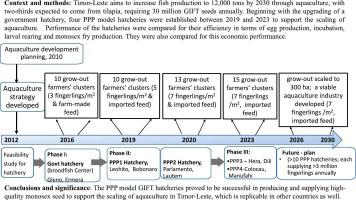当前位置:
X-MOL 学术
›
Agric. Syst.
›
论文详情
Our official English website, www.x-mol.net, welcomes your
feedback! (Note: you will need to create a separate account there.)
Sustainable production and dissemination of genetically improved farmed tilapia seed in smallholder farming systems: A case study from Timor-Leste
Agricultural Systems ( IF 6.1 ) Pub Date : 2024-06-17 , DOI: 10.1016/j.agsy.2024.104031 Jharendu Pant , Ram C. Bhujel , Adriano Dani F. du Carmu , Lucas Soares de Jesus , Silvino Gomes , Mario Pereira , Shwu Jiau Teoh
Agricultural Systems ( IF 6.1 ) Pub Date : 2024-06-17 , DOI: 10.1016/j.agsy.2024.104031 Jharendu Pant , Ram C. Bhujel , Adriano Dani F. du Carmu , Lucas Soares de Jesus , Silvino Gomes , Mario Pereira , Shwu Jiau Teoh

|
Timor-Leste's National Aquaculture Development Strategy (NADS) 2012–30 aims to achieve an annual aquaculture production of 12,000 tons by 2030 to raise per capita fish consumption from 6.1 kg in 2010 to 15 kg. Genetically Improved Farmed Tilapia (GIFT) is identified as the most suitable species under Timor-Leste's existing farming systems and agro-ecological context. It is expected to account for two-thirds of total aquaculture production, requiring over 30 million fingerlings annually, necessitating a strong role of public and private sectors to develop a sustainable hatchery model for producing and supplying high quality GIFT fingerlings to fish farmers on a mass-scale. The major objective was to conceptualize and apply a public-private partnership (PPP) model to produce and disseminate high-quality monosex GIFT seed by public and private hatcheries across Timor-Leste. Model GIFT hatcheries were established and monitored using a standard protocol developed by the R&D team. Data on total eggs, clutch size, incubation survival rate, swim-up fry, and monosex fry produced were recorded on a weekly basis. The performance of hatcheries was compared using descriptive statistics at a 5% level of significance. Economic analysis was conducted to compare production costs, gross profits, and net profits among hatcheries and nurseries. Enabling conditions and factors for effective PPP were identified. The WorldFish, in collaboration with Timor-Leste's Ministry of Agriculture and Fisheries, upgraded an existing public hatchery in Gleno, Ermera, introduced GIFT in 2015, and developed it as a GIFT broodstock centre to supply quality brood fry to other hatcheries. To produce monosex seed on a mass-scale, four PPP model GIFT hatcheries were established between 2019 and 2023. Results from a public hatchery and two initially established PPP model hatcheries showed that the hatchery in Parlamento had significantly higher ( < 0.05) monthly production of eggs, swim-up fry, monosex fry, and clutch sizes. On average, over 177,000 monosex fry per month were produced by those three hatcheries. Local service providers (LSPs), self-employed youths who have been recruited and trained to facilitate input supply and output marketing, purchase GIFT fry from the hatcheries, nurse them to fingerling size, and supply them to farmers. To achieve high seed production and supply targets, scaling of PPP model hatcheries, nurseries, and LSPs along with effective training and technical back-up, favourable policies, institutional environments, and governance mechanisms, is necessary. The PPP model GIFT hatcheries are scalable across inland farming systems in Timor-Leste and other countries with similar agro-ecological, socio-economic, and climatic contexts.
中文翻译:

小农养殖系统中转基因罗非鱼种子的可持续生产和传播:东帝汶的案例研究
东帝汶2012-30年国家水产养殖发展战略(NADS)的目标是到2030年实现水产养殖年产量12,000吨,将人均鱼类消费量从2010年的6.1公斤提高到15公斤。转基因养殖罗非鱼(GIFT)被认为是东帝汶现有养殖系统和农业生态背景下最合适的品种。预计将占水产养殖总产量的三分之二,每年需要超过 3000 万尾鱼种,需要公共和私营部门发挥强有力的作用,开发可持续的孵化场模式,为养鱼户大规模生产和供应高质量的 GIFT 鱼种-规模。主要目标是构思并应用公私合作伙伴关系 (PPP) 模式,通过东帝汶各地的公共和私人孵化场生产和传播高质量的单性 GIFT 种子。使用研发团队开发的标准协议建立和监控 GIFT 模型孵化场。每周记录总产卵量、窝数、孵化成活率、游上鱼苗和单性鱼苗的数据。使用描述性统计数据以 5% 的显着性水平对孵化场的绩效进行比较。通过经济分析比较孵化场和苗圃的生产成本、毛利润和净利润。确定了有效 PPP 的有利条件和因素。 WorldFish 与东帝汶农业和渔业部合作,升级了位于埃尔梅拉格莱诺的现有公共孵化场,并于 2015 年引入 GIFT,并将其发展为 GIFT 亲鱼中心,为其他孵化场提供优质亲鱼苗。为了大规模生产单性种子,2019 年至 2023 年间建立了四个 PPP 模式 GIFT 孵化场。 一个公共孵化场和两个最初建立的 PPP 模式孵化场的结果表明,Parlamento 孵化场的卵、游上鱼苗、单性鱼苗和每窝规格的月产量显着较高 (< 0.05)。这三个孵化场平均每月生产超过 177,000 尾单性鱼苗。当地服务提供商 (LSP) 是经过招募和培训以促进投入供应和产出营销的个体青年,他们从孵化场购买 GIFT 鱼苗,将其培育至鱼种大小,然后将其供应给农民。为了实现高种子产量和供应目标,有必要扩大PPP模式孵化场、苗圃和LSP的规模,并提供有效的培训和技术支持、有利的政策、制度环境和治理机制。 PPP 模式 GIFT 孵化场可在东帝汶和其他具有相似农业生态、社会经济和气候背景的国家的内陆农业系统中进行扩展。
更新日期:2024-06-17
中文翻译:

小农养殖系统中转基因罗非鱼种子的可持续生产和传播:东帝汶的案例研究
东帝汶2012-30年国家水产养殖发展战略(NADS)的目标是到2030年实现水产养殖年产量12,000吨,将人均鱼类消费量从2010年的6.1公斤提高到15公斤。转基因养殖罗非鱼(GIFT)被认为是东帝汶现有养殖系统和农业生态背景下最合适的品种。预计将占水产养殖总产量的三分之二,每年需要超过 3000 万尾鱼种,需要公共和私营部门发挥强有力的作用,开发可持续的孵化场模式,为养鱼户大规模生产和供应高质量的 GIFT 鱼种-规模。主要目标是构思并应用公私合作伙伴关系 (PPP) 模式,通过东帝汶各地的公共和私人孵化场生产和传播高质量的单性 GIFT 种子。使用研发团队开发的标准协议建立和监控 GIFT 模型孵化场。每周记录总产卵量、窝数、孵化成活率、游上鱼苗和单性鱼苗的数据。使用描述性统计数据以 5% 的显着性水平对孵化场的绩效进行比较。通过经济分析比较孵化场和苗圃的生产成本、毛利润和净利润。确定了有效 PPP 的有利条件和因素。 WorldFish 与东帝汶农业和渔业部合作,升级了位于埃尔梅拉格莱诺的现有公共孵化场,并于 2015 年引入 GIFT,并将其发展为 GIFT 亲鱼中心,为其他孵化场提供优质亲鱼苗。为了大规模生产单性种子,2019 年至 2023 年间建立了四个 PPP 模式 GIFT 孵化场。 一个公共孵化场和两个最初建立的 PPP 模式孵化场的结果表明,Parlamento 孵化场的卵、游上鱼苗、单性鱼苗和每窝规格的月产量显着较高 (< 0.05)。这三个孵化场平均每月生产超过 177,000 尾单性鱼苗。当地服务提供商 (LSP) 是经过招募和培训以促进投入供应和产出营销的个体青年,他们从孵化场购买 GIFT 鱼苗,将其培育至鱼种大小,然后将其供应给农民。为了实现高种子产量和供应目标,有必要扩大PPP模式孵化场、苗圃和LSP的规模,并提供有效的培训和技术支持、有利的政策、制度环境和治理机制。 PPP 模式 GIFT 孵化场可在东帝汶和其他具有相似农业生态、社会经济和气候背景的国家的内陆农业系统中进行扩展。
















































 京公网安备 11010802027423号
京公网安备 11010802027423号